warning lights CHEVROLET S10 1994 2.G Owners Manual
[x] Cancel search | Manufacturer: CHEVROLET, Model Year: 1994, Model line: S10, Model: CHEVROLET S10 1994 2.GPages: 340, PDF Size: 18.45 MB
Page 10 of 340
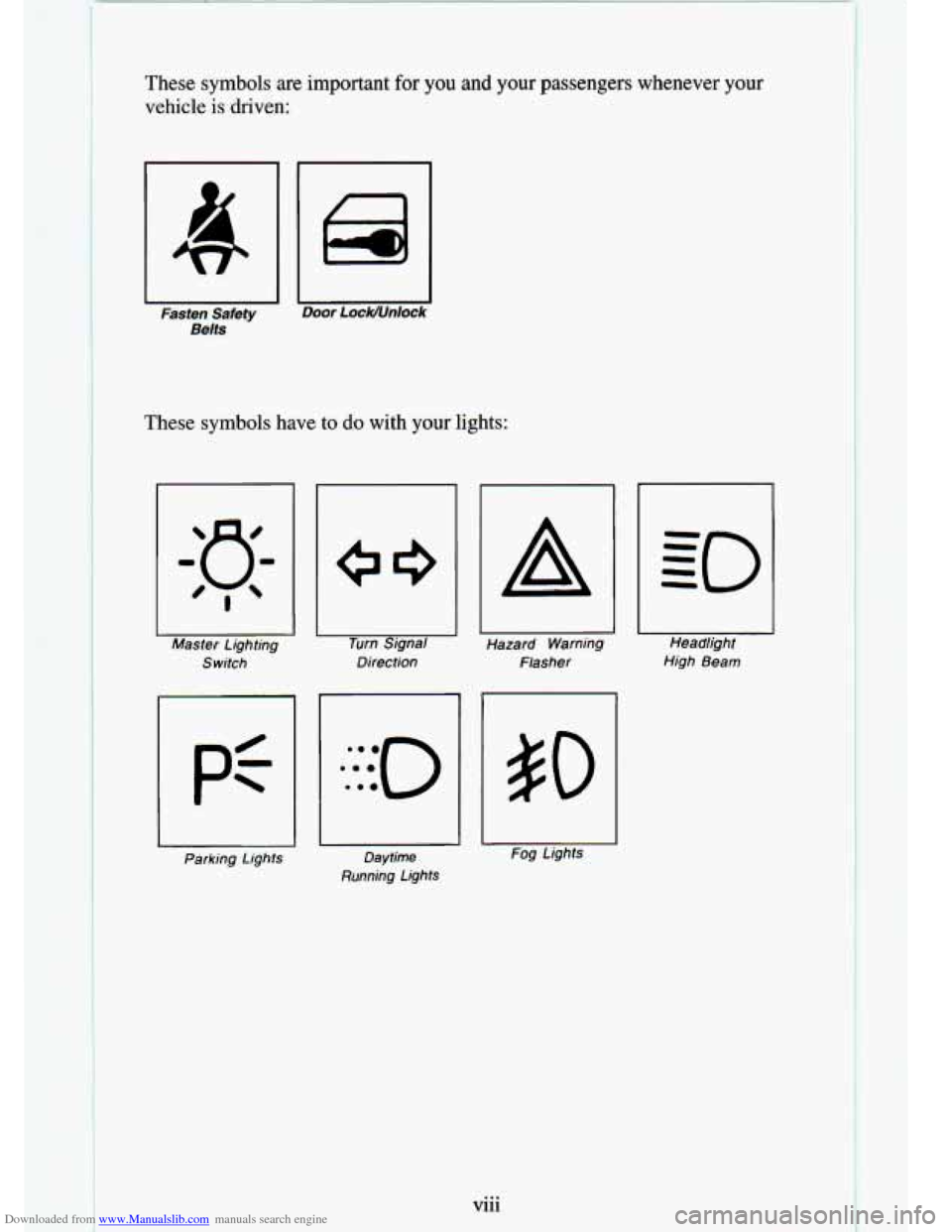
Downloaded from www.Manualslib.com manuals search engine These symbols are important for you and your passengers whenever vour
vehicle is driven:
2U
Fasten Safety Door LocwUnlock
Belts
These symbols have to do with your lights:
Master Lighting
Switch Turn
Signal
Direction
**.*:o .e.
Parking Lights Daytime
Running Lights
A
Hazard Warning Flasher
I Fog Lights Headlight
High Beam
viii.
Page 11 of 340
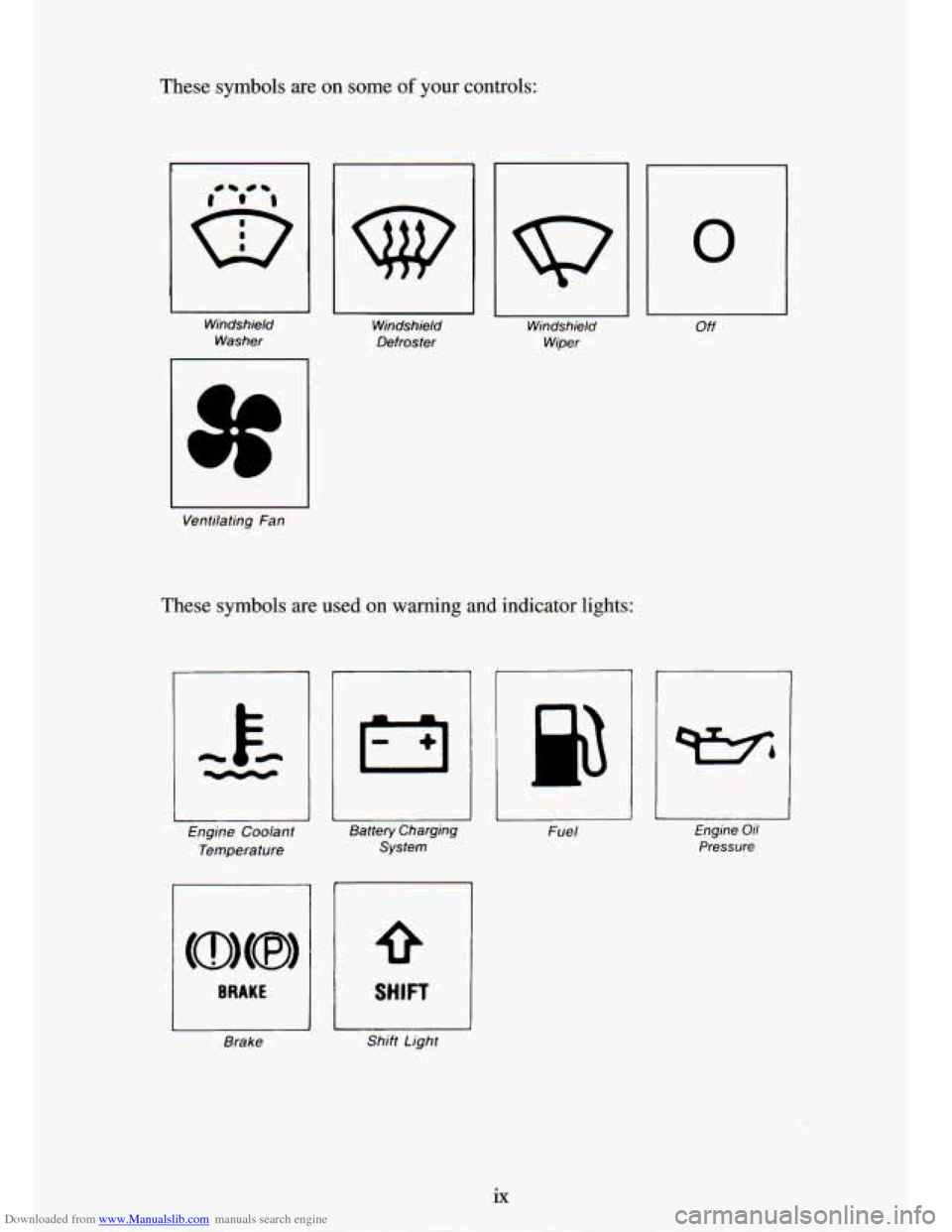
Downloaded from www.Manualslib.com manuals search engine These symbols are on some of your controls:
Windshield Washer Windshield
Defroster Windshield
Wiper
I
Ventilating Fan
These symbols are used on warning and indicator lights:
Engine Coolant
Temperature
BRAKE
Brake Battery Charging
System
I SHIFT
I
Shift Light Fuel
0
Off
Engine Oil
Pressure
Page 104 of 340
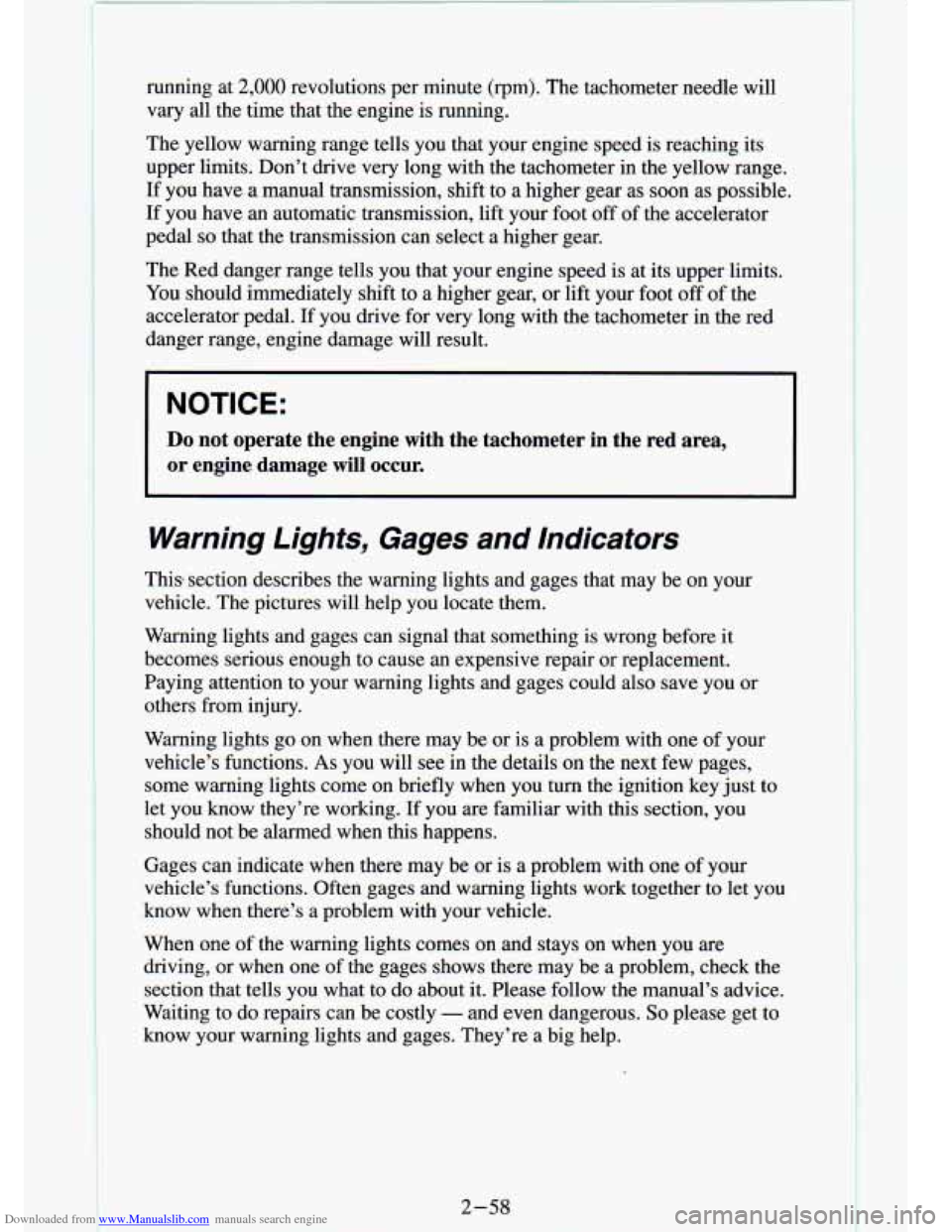
Downloaded from www.Manualslib.com manuals search engine running at 2,000 revolutions per minute (rpm). The tachometer needle will
vary all the time that the engine is running.
The yellow warning range tells you that your engine speed is reach\
ing its
upper limits. Don’t drive very long with the tachometer in the yellow range.
If you have a manual transmission, shift to a higher gear as soon as possible.
If you have an automatic transmission, lift your foot off
of the accelerator
pedal
so that the transmission can select a higher gear.
The Red danger range tells you that your engine speed is at its upper limits.
You should immediately shift to a higher gear, or lift your foot
off of the
accelerator pedal. If you drive for very long with the tachometer in the red
danger range, engine damage will result.
NOTICE:
Do not operate the engine with the tachometer in the red area,
or engine damage
will occur.
I
Warning Lightsy Gages and Indicators
This section describes the warning lights and gages that may be on your
vehicle. The pictures will help you locate them.
Warning lights and gages can signal that something is wrong be\
fore it
becomes serious enough to cause an expensive repair or replacem\
ent.
Paying attention to your warning lights and gages could also s\
ave you or
others from injury.
Warning lights
go on when there may be or is a problem with one of your
vehicle’s functions.
As you will see in the details on the next few pages,
some warning lights come on briefly when you turn the ignition\
key just to
let you know they’re working. If you are familiar with this sec\
tion, you
should not
be alarmed when this happens.
Gages can indicate when there may be or is a problem with one
of your
vehicle’s functions. Often gages and warning lights work toge\
ther to let you
know when there’s a problem with your vehicle.
When one of the warning lights comes on and stays on when you are
driving, or when one of the gages shows there may be a problem, check the
section that tells you what to
do about it. Please follow the manual’s advice.
Waiting to do repairs can be costly
- and even dangerous. So please get to
know your warning lights and gages. They’re a big help.
2-58
I
Page 184 of 340
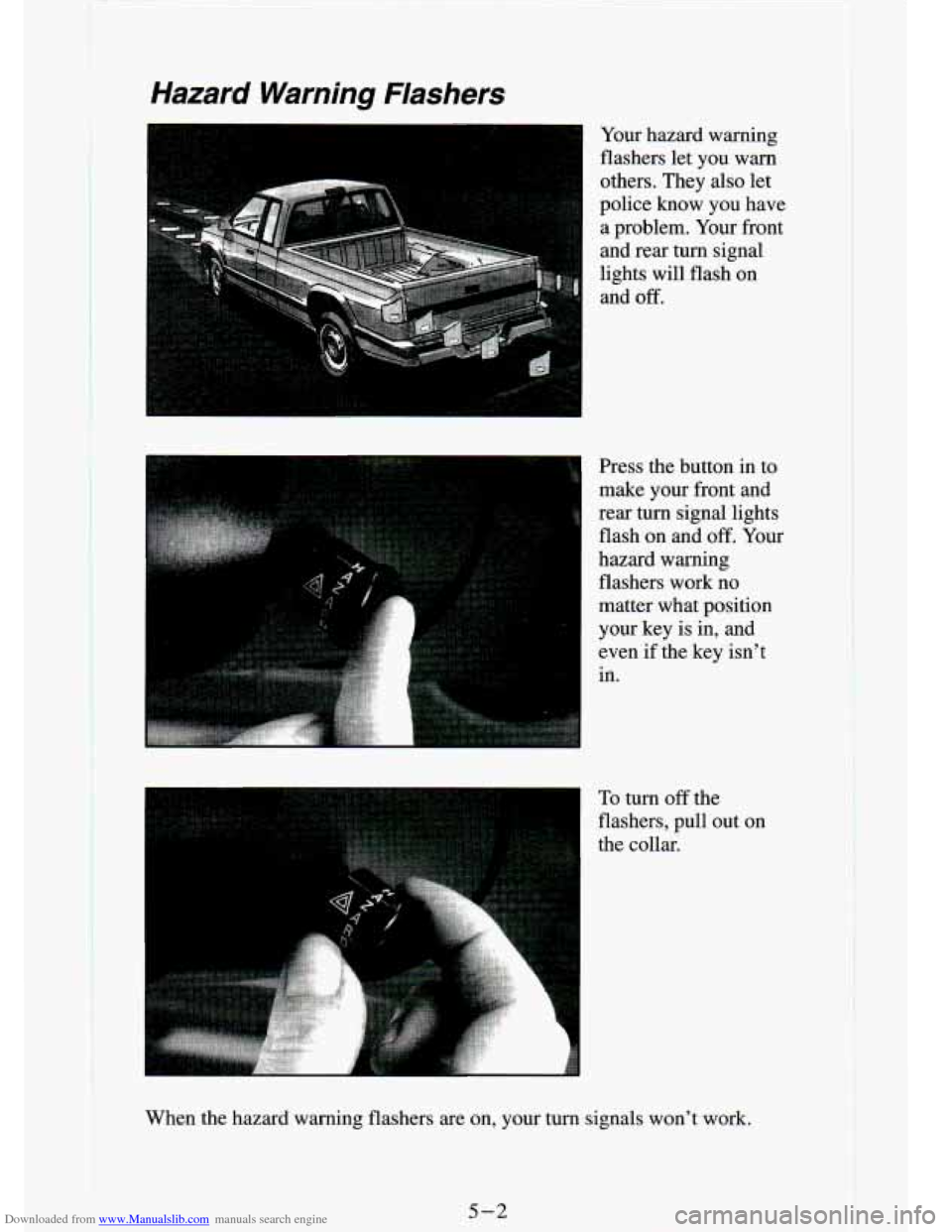
Downloaded from www.Manualslib.com manuals search engine Hazard Warning Flashers
-1 Your hazard warning
flashers let you warn
others. They also let
and
off.
I police know you have a problem. Your front
and rear turn signal
lights will flash on
Press the button in to
make your front and
rear
turn signal lights
flash on and off. Your
hazard warning
flashers work no
matter what position
your key is in, and
even if the key isn’t
in.
To turn off the
flashers, pull out
on
the collar:
When the hazard warning flashers are
on, your turn signals won’t work.
Page 241 of 340
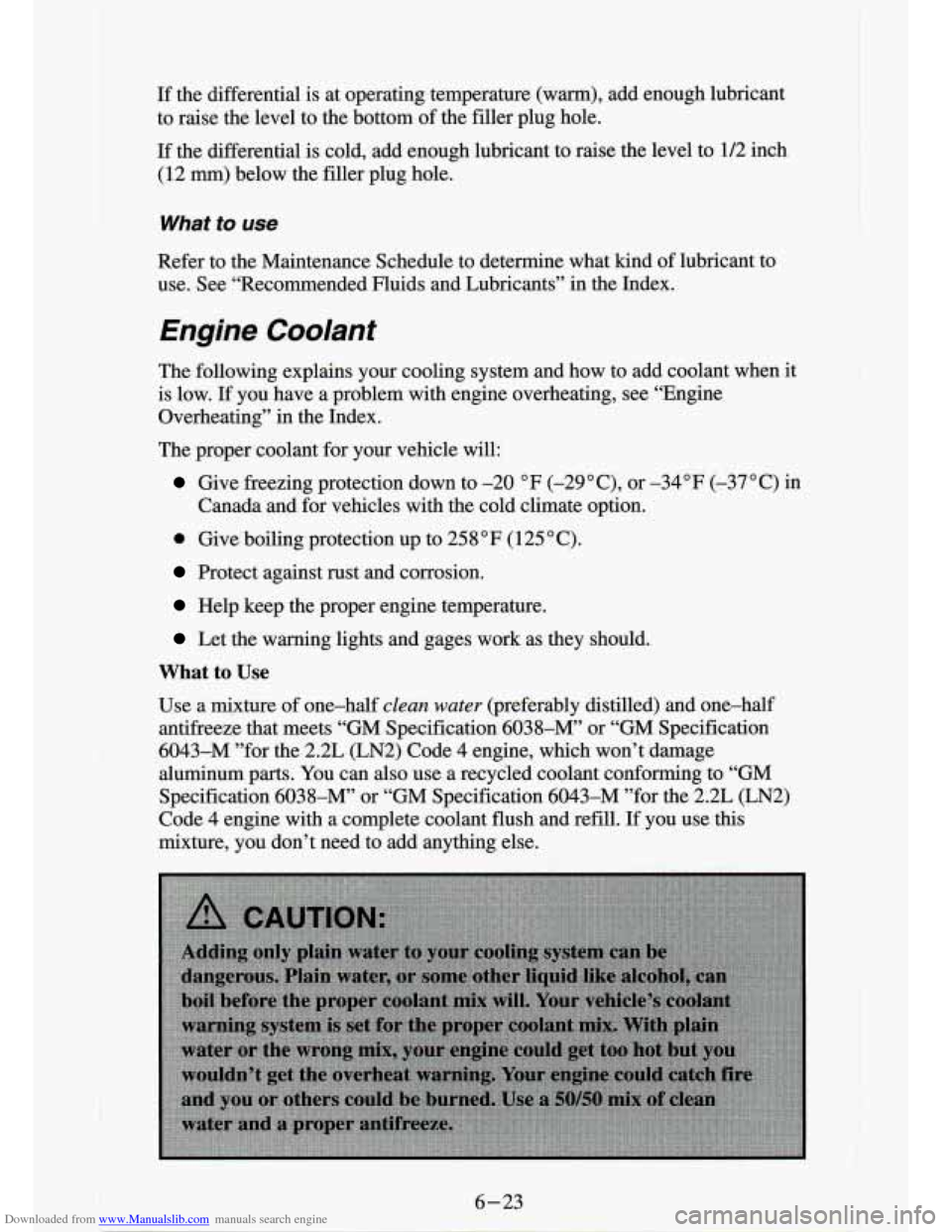
Downloaded from www.Manualslib.com manuals search engine If the differential is at operating temperature (w,arm), add enou\
gh lubricant
to raise the level to the bottom of the filler plug hole.
If the differential is cold, add enough lubricant to raise the level to 1/2 inch
(12
mm) below the filler plug hole.
What to use
Refer to the Maintenance Schedule to determine what kind of lubricant to
use. See “Recommended Fluids and Lubricants” in the Index.
Engine Coolant
The following explains your cooling system and how to add coolant \
when it
is low.
If you have a problem with engine overheating, see “Engine
Overheating” in the Index.
The proper coolant for your vehicle will:
Give freezing protection down to -20 “F (-29” C), or -34°F (-37 “C) in
Canada and for vehicles with the cold climate option.
e Give boiling protection up to 258°F (125°C).
Protect against rust and corrosion.
Help keep the proper engine temperature.
Let the warning lights and gages work as they should.
What to Use
Use a mi,xture of one-half clean water (preferably distilled) and one-half
antifreeze that meets “GM Specification 603%” or “GM Specification
6043-M ”for the 2.2L (LN2) Code 4 engine, which won’t damage
aluminum parts. You can also use
a recycled coolant conforming to “GM
Specification 603%” or “GM Specification 6043-M ”for the 2.2L (LN2)
Code 4 engine with a complete coolant flush and refill.
If you use this
mixture, you don’t need to add anything else.
6-23
Page 332 of 340
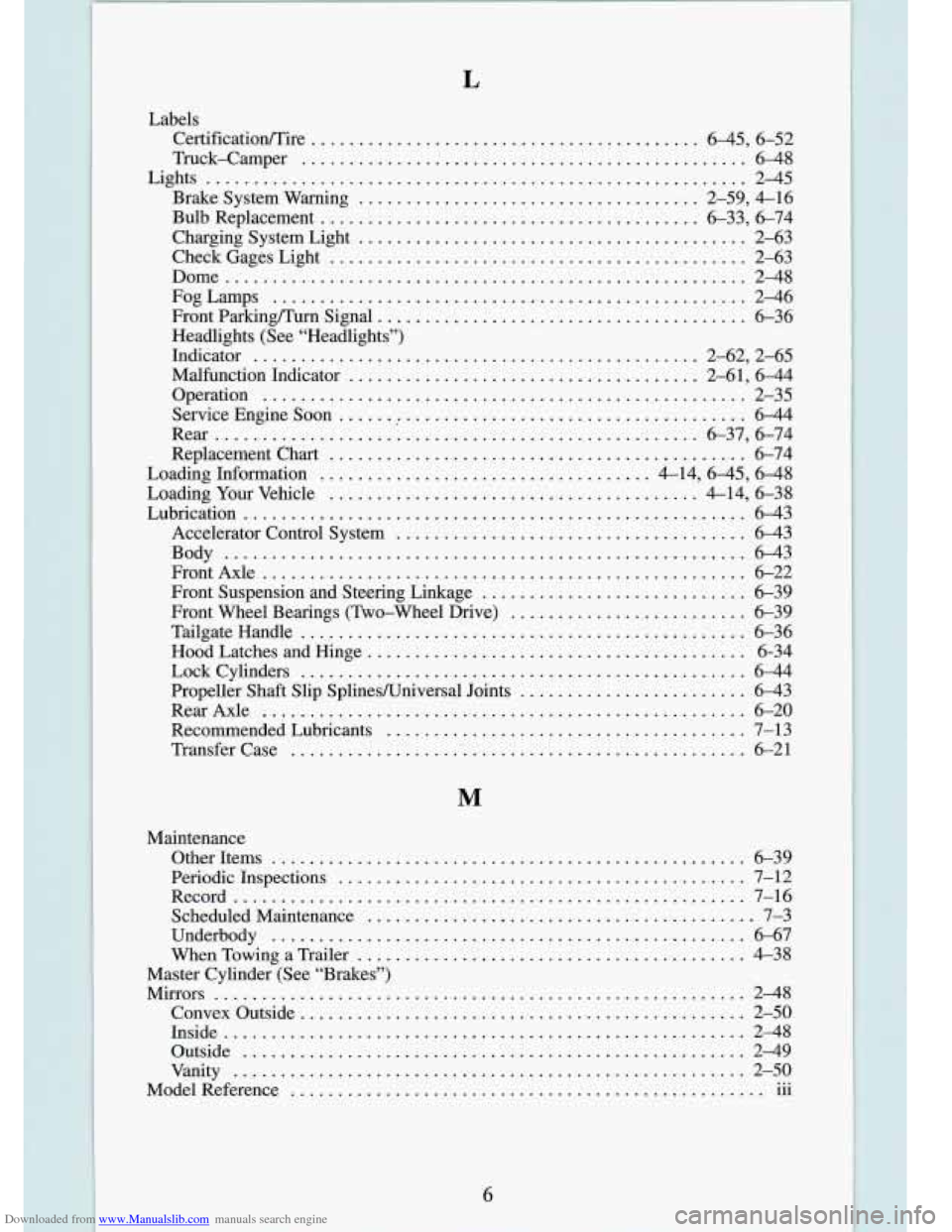
Downloaded from www.Manualslib.com manuals search engine L
Labels CertificatiodI‘ire
......................................... 6-45. 6.52
Truck-Camper
............................................... 6-48
Lights
......................................................... 2-45
Brake System Warning
.................................... 2.59. 4-16
Bulb Replacement
........................................ 6.33. 6-74
Charging System Light
......................................... 2-63
CheckGagesLight
............................................ 2-63
Dome
....................................................... 2-48
FogLamps
.................................................. 2-46
Front ParkingEurn Signal
....................................... 6-36
Headlights (See “Headlights”)
InQcator
............................................... 2.62. 2.65
Malfunction Indicator
..................................... 2.61. 6-44
Operation
................................................... 2-35
ServiceEngineSoon
........................................... 6-44
Rear
................................................... 6-37, 6-74
Replacement Chart
............................................ 6-74
Loading Information
................................... 4-14,645, 6-48
Loading Your Vehicle
....................................... 4-14, 6-38
Lubrication
..................................................... 6-43
Accelerator Control System
..................................... 6-43
Body
....................................................... 6-43
FrontAxle
................................................... 6-22
Front Suspension and Steering Linkage
............................ 6-39
Front Wheel Bearings (Two-Wheel Drive)
......................... 6-39
TailgateHandle
............................................... 6-36
HoodLatchesandHinge
........................................ 6-34
Lock Cylinders
............................................... 6-44
Propeller Shaft Slip SplinesNniversal Joints
........................ 6-43
RearAxle
................................................... 6-20
RecommendedLubricants
...................................... 7-13
Transfer Case
................................................ 6-21
M
Maintenance OtherItems
.................................................. 6-39
Record
...................................................... 7-16
ScheduledMaintenance
......................................... 7-3
Underbody
.................................................. 6-67
WhenTowingaTrailer
......................................... 4-38
Master Cylinder (See “Brakes”) Mirrors
........................................................ 2-48
Convexoutside
............................................... 2-50
Inside
....................................................... 2-48
Outside
..................................................... 2-49
Vanity
...................................................... 2-50
ModelReference
.................................................. 111
Periodic Inspections ........................................... 7-12
...
6